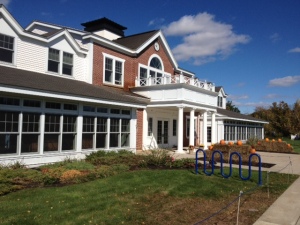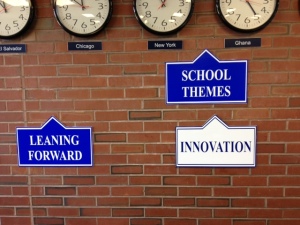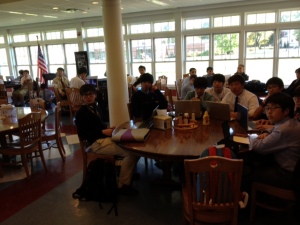Organizations innovate either because they want to, need to, or both. This is the story of a school that really needed to innovate, back to the wall and the wolf at the door. After getting past that, they have used those trials to create an organization that is flat, nimble, and open to trying new ideas. Getting there has been tough, but tough is sometimes what innovation is about.
 The Hillside School is not big or necessarily one that most people have heard of. It is one of the smaller schools I will visit on my journey, tucked up on a beautiful hill about 30 miles west of Boston. Back in the day it was a sanatorium, then a working farm school for boys, and then a school for what back then would have been politely called “troubled” young men. Now we know that many of these children have learning differences and need a special kind of education.
The Hillside School is not big or necessarily one that most people have heard of. It is one of the smaller schools I will visit on my journey, tucked up on a beautiful hill about 30 miles west of Boston. Back in the day it was a sanatorium, then a working farm school for boys, and then a school for what back then would have been politely called “troubled” young men. Now we know that many of these children have learning differences and need a special kind of education.
When Head Dave Beecher took over 15 years ago, the school was in crisis. The previous head had suddenly passed away, enrollment was critically low, and the school was on the verge of closing. Over a period of three years the Board held three emergency meetings, and on the third voted 13-12 to keep the school open. Dave said that year he would meet the food delivery truck at the end of the road with a wad of $50 bills to pay them because vendors would not take their checks. The term “grit” has become trendy recently. Dave and his team back then had grit. They also knew that if they did not do something pretty darn innovative pretty darn quickly, a school with an important mission was going to close the doors.
Back then Hillside was a boarding Middle School, serving boys in grades 5-9 with the range of social, academic, and emotional issues that make attending a regular school difficult. Hillside decided they needed to broaden their demographic in order to survive so they redirected their value proposition to make the school attractive to boys who do not have these same special learning needs. They reached out for ESL students and boys interested in athletics. They set a goal, which they achieved, of roughly 50% of students with special needs and 50% not. It worked. The school is still open, enrollment is strong, and they are fulfilling an important mission.
The struggle to come out of a ditch did provide one positive and important lesson in innovation: you take advantage of circumstances to meet both short term and long-term objectives. We have seen that inertia, that system of long-standing tradition, turf, and mindset is one of the key obstacles to innovation. Dave says that the near closing of the school allowed them to essentially start with a clean slate and decide who and what they wanted to be, to start free of inertia on a new path. Some will say “Well, that made their path easier. They did not have to deal with turning a big ship around.” Tell that with a straight face to the guy who stood at the end of the road buying food with cash for his boys.
Hillside now serves about 130 boys. They have five core values: respect, compassion, determination, honesty, and fun. They added “fun” after reflecting on how few of us remember our middle school years as being any kind of fun. The goal is to provide a level of social, emotional, and academic support for all of their students, regardless of special needs, in order to get them prepared for mainstream learning settings. Their core values are posted on the walls and echoed in the halls by faculty in class and by the students in their daily community lunch meetings. Dave and Associate Head Dan Marchetti translated what their goals mean for them every day within the context of a mixed community of students:
- Meet every kid every at their Point A and bring them along to their Point B.
- Provide rapid and continual assessment and feedback.
- Emphasize many opportunities for success for boys who may not have had many.
I then asked them what innovation means to them. Are they focusing on 21C skills? Are they trying to make the students more independent? Better communicators? They both said that innovation to them means “getting better every day at doing what we do, preparing boys for the next step. Our mission stays the same, but we know we can always do better.”
 Over the past year the entire Hillside faculty and staff was involved in an ongoing innovation brainstorm. Each department, including administration departments, came up with a list of ideas about what they could change that would make Hillside a better school. No conditions were placed on the ideas. Then they filtered the ideas down to 3-5 per department and went right to a feasibility stage on that set of ideas: enhance the entrance to the school; create a new media lab; develop a speaker series on health and wellness; and many more. Dan said there were several important outcomes from this exercise that went well beyond the ideas they decided had value:
Over the past year the entire Hillside faculty and staff was involved in an ongoing innovation brainstorm. Each department, including administration departments, came up with a list of ideas about what they could change that would make Hillside a better school. No conditions were placed on the ideas. Then they filtered the ideas down to 3-5 per department and went right to a feasibility stage on that set of ideas: enhance the entrance to the school; create a new media lab; develop a speaker series on health and wellness; and many more. Dan said there were several important outcomes from this exercise that went well beyond the ideas they decided had value:
- Created a mindset that it is OK to re-invent yourself frequently
- Continually refreshes team thinking
- Engages everyone in the admissions/marketing of the school
They are probably going to renew this exercise every year. What Hillside did was to engage in the all-school value proposition discussion, one that engages the entire school about what actually brings value as viewed through the eyes of the customer.
A group of teachers shared some of their keys to acting as “value ambassadors” for the school, in how they have learned to “do what we do but do it better”. I am reflecting on how this level of detail contrasts with the “big ideas” discussions I have been having, how the teachers at Hillside have filtered the idea of innovation straight down to the personal relationship and stake they have in each of their students.
- Ask what has value to the students, and figure out how to make that one additional connection.
- Teach students how to meet with success.
- Give permission to the students to be themselves without having to constantly seek permission from adults.
- Find ways for students to take risks, particularly when they have not succeeded with risk taking in the past.
We reflected with Dave over his success at bringing a school back from the brink and making it successful over a period of 15 years:
- No entrenched faculty groups. They started with almost a blank canvas because the school was in real trouble. Any inertia that had built up prior to that point had to go.
- Hiring the right people. “When I interview someone to teach here, all that I am really focusing on is whether the person in front of me is someone who already lives our core values.”
- Steady, ongoing “brainwashing of the faculty and students in our core values”.
- Walking in on classrooms all the time, every day, even if just for a couple of minutes.
- “Never in 15 years have I said no to a good idea, and I want to retire with that record.”
- We only have Board meetings when we need them.
 Hillside is not a big complicated school. They don’t have to deal with AP’s and college admissions. The faculty lives and works together. They have little in the way of organizational structure. One might think that innovation in a place like this is easy; one would be wrong. The school is small but the detail with which every day and class is imbued is exceedingly complex, because with many of the boys at this school you don’t get many chances to get it wrong. Innovation means getting better in ways that might be at the margins for some of us, but are at the core of what they do at Hillside. These are lessons worth learning for all of us
Hillside is not a big complicated school. They don’t have to deal with AP’s and college admissions. The faculty lives and works together. They have little in the way of organizational structure. One might think that innovation in a place like this is easy; one would be wrong. The school is small but the detail with which every day and class is imbued is exceedingly complex, because with many of the boys at this school you don’t get many chances to get it wrong. Innovation means getting better in ways that might be at the margins for some of us, but are at the core of what they do at Hillside. These are lessons worth learning for all of us




[…] Organizations innovate either because they want to, need to, or both. This is the story of a school that really needed to innovate, back to the wall and the wolf at the door. After getting past t… […]